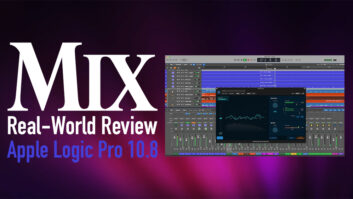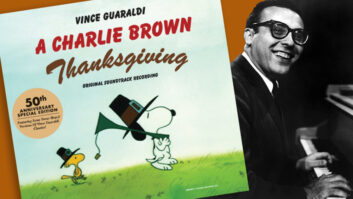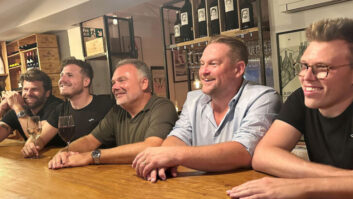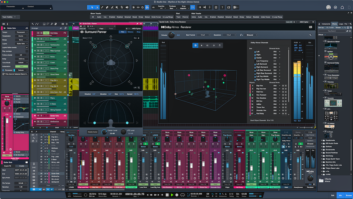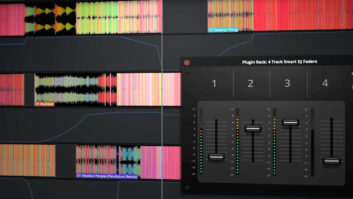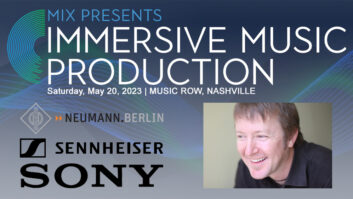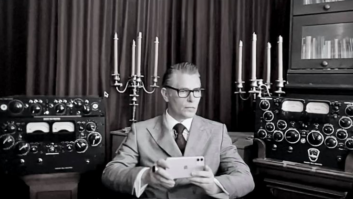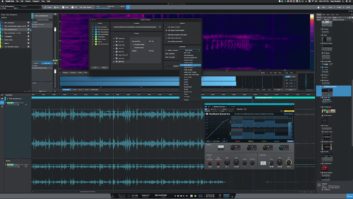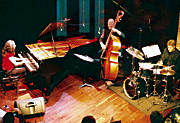

In the past few years, one of the most hotly debated topics on pro audio Internet forums has been high-resolution audio and its effect (or lack of) on everything from audio sales to listeners’ physical and mental health. Conspicuously absent has been a verifiable resolution comparison method accessible by end-users. And while those who have access to expensive, higher-resolution audio equipment generally agree that “high-rez” audio is important for archiving, many say that “the masses” or “the iPod generation” either cannot hear the difference in quality between 192kHz/24-bit audio and low bit-rate MP3 files, or they simply do not care. Meanwhile, those who do not have access to expensive, higher-resolution audio equipment argue that the capture medium is irrelevant if the artistic merit is lacking.
Miking the Mary Louise Knutson Trio. Mics are highlighted.
Enter Generator LLC, a consulting firm dedicated to product creation and development. Founder and producer John Calder has a background in major-label audio engineering, combined with experience as a product specialist, advertising writer, marketing director and product creator. He also witnessed format war debates first-hand when he was the marketing director at Minnetonka Audio Software Inc., creating the discWelder DVD-authoring product line. Minnetonka is well-known for its software encoding products for DTS, AC-3 and MLP, so Calder was in an excellent position to observe the need for a tool that would let end-users compare audio captures at various resolutions with different distribution formats. The tool for the job was a DVD-A disc called The Resolution Project.
ANATOMY OF A PROJECT
The challenge facing The Resolution Project was to record two musical styles that were particularly appropriate for high-resolution and surround delivery — jazz and classical — so that several resolutions could be captured simultaneously while holding other variables constant, including microphones and microphone placement, converters and recording media. The raw material had to be engineered into several different formats that could be presented using one medium. The end-user would then be able to monitor all resolutions and formats in one sitting, in the same environment, with the same converters and monitoring system — all with very little time lapse between chosen segments. Having random access to audio segments was also a prime factor in choosing the design for The Resolution Project‘s delivery format.
Calder chose the Mary Louise Knutson Trio (Knutson, piano; Gordon Johnson, acoustic bass; and Phil Hey, drums) to perform Knutson’s jazz composition “Merle the Pearl” (Meridian Jazz) at the Dakota Jazz Club and Restaurant in Minneapolis. The group played on the club’s corner stage, which has curtains, in front of a live audience. A fairly “live” venue, the club’s seating includes a balcony around two sides; the band addressed the audience diagonally.
The Artaria String Quartet (Ray Shows, violin; Nancy Oliveros, violin; Annalee Wolf, viola; and Thomas Rosenberg, cello) performed “Presto” (Opus 20/4) by Franz Josef Haydn at the Church of St. John the Evangelist in St. Paul. The church, a larger venue than the Dakota Jazz Club, sounded “nicely dry and woody,” according to Calder. The quartet performed without an audience.
NAVIGATING A CAREFULLY CHOSEN SIGNAL PATH
Five DPA 4052 omni microphones in a horizontal array captured the acoustic space. Left and right microphones were 30 degrees from the center axis, with left surround and right surround mics configured 135 degrees from center. Left and right microphones were used for capturing left/front and right/front surround format signals, as well as left and right stereo. Only five discrete channels (L/R/C/Ls/Rs) were recorded. According to Calder, “An LFE channel was not recorded, eliminating bass-management inconsistency.”
For the jazz trio, the array was positioned six feet from the front of the stage and 12 feet from the floor; for the string quartet, the array was 18 feet from the front of the ensemble and 13 feet high. Using the DPA hangers, the 4052s were angled 30 degrees down off the horizontal axis. Bruce Myers of DPA Microphones elaborates, “It is always good practice to aim your omni mics for best high-frequency results. This is a simple fact of physics. Generally, and all [other] things being equal, an omni-patterned mic will maintain its omnidirectionality as long as the wavelength is greater than the size of the microphone diaphragm. Our omni mics with 16mm [0.63-inch] diaphragms will show in octave-to-octave polar plots that they begin to become directional by 15 kHz.

Miking for stereo and surround: Five DPA 4052s were hung in an adjustable horizontal array, each angled 30 degrees toward the floor. When recording the jazz trio, the array was positioned six feet from the stage and 12 feet from the floor; for the string quartet, the array was 18 feet from the front of the ensemble and 13 feet high.
“[With the 4052,] I knew we were offering our very best, highest-resolution, small-diameter omni model. Higher-resolution formats are all about achieving the greatest level of detail possible. After all, in recording you can only get as close to the music as the mic capsule. If you don’t get it right at the capsule, there is nothing you can put in-line to fix it.”
Great River Electronics’ MP-2NVs microphone preamplifiers were also chosen. According to Great River’s Dan Kennedy, “We used the MP-2NVs because, frankly, that’s all I had available. I think the [string] quartet would have benefited from the MP-2MH, it being cleaner and a bit better in the high-frequency detail department, but I like the combination of the DPA mics and the NV for the jazz set. It really feels live, not clinical.” The MP-2NV circuitry is similar to that of the Neve 1073 channel amplifier, while the MP-2MH is noted for its noise rejection due to its transformer-coupled input.
Monster Cable provided cabling and power conditioning with Monster Microphone Cables Series 500 and the Monster Power PowerCenter Pro 3500. Monster Cable’s Tim Pryde says, “The Monster Microphone Cables utilize our patented Time Correct Windings, [which allow] all of the audio frequencies [highs/mids/lows] to travel and arrive at the destination point at the same time.” According to Pryde, the PowerCenter Pro 3500 cleans RF and EMI noise from the signal so that the noise floor will interfere less with the articulation and detail in the recorded audio.
Calder simultaneously recorded five channels of PCM audio at three different audio resolutions: 16-bit/44.1 kHz, 24-bit/96 kHz and 24-bit/192 kHz. Five Great River MP-2NVs were routed to three Genex Audio GX9048s. Genex’s Kevin Brown says that the 9048s offered many appropriate features for the task, including “embedded design, small form factor [and our] converters are built into the unit, which really helps in a complex setup such as this.” The GX9048 is capable of recording 48 channels of 24-bit/192 kHz or 48 channels of DSD in a single 4U rackmount box. For The Resolution Project, the GX9048s were fitted with Kingston hot-swappable hard drives formatted as FAT32. The recorder was placed in PCM mode to record standard .WAV files.
EDITING AND FILE COMPRESSION
After recording both performances on April 21, 2005, Calder removed the Kingston drives and transferred their contents to his workstation for editing with Nuendo 3. No digital format transcoding, sample-rate decimation or dithering was done to arrive at the various resolutions, with the exception of data-compressed formats such as MP3, WMA and AAC.
Each selection was individually edited for length; listeners will note that the fades from digital audio black to the noise floor have differing slopes. The character of the noise floor provides one point for critical analysis when the DVD-A is played in a suitably quiet monitoring environment.
Nuendo was chosen as the editing platform due to its floating-point processing. “The system is 32-bit floating point, making it ideal for optimizing dynamic range and noise floor,” says Fadi Hayek at Yamaha (which bought Steinberg last year). “Second, Nuendo can record up to 384kHz sampling rate. This, of course, is dependent on whether your A-to-Ds and D-to-As are capable of the resolution. All editing in Nuendo is based on the selected resolution. However, mixing always defaults to 384 kHz, meaning that you could automate at a resolution of 384,000 pulses per second. This makes for some really smooth-sounding crossfades.” Calder also liked Nuendo’s built-in format conversion for MP3 and WMA file compression.
CODECS AND AUTHORING
Dolby’s Meridian Lossless Packing (MLP) enabled extra space for high-resolution tracks on the DVD-A, while MPEG 1 Audio Layer 3 (MP3), Windows Media Audio (WMA) and Dolby’s (MPEG 4) Advanced Audio Coding (AAC) were used to demonstrate lossy compression artifacts. All lossy formats were encoded at 64 kbits/second.
Calder explains, “The three data-compressed formats [MP3, WMA and AAC] were encoded from the 16-bit/44.1kHz stereo selections in exactly the same popular method utilized to convert CD tracks for playback on portable digital audio players, then transcoded back into 16/44.1 resolution. DVD-A does not allow lossy data-compressed formats. There is nearly zero signal degradation when transcoding from compressed into uncompressed formats, so the listening experience remains completely valid for all audio resolutions.”
Calder used Apple’s iTunes to convert audio to AAC. For MLP compression, Minnetonka Audio’s SurCode MLP was employed. MP3 and WMA files were generated using Nuendo’s codecs. For the presentation platform, Calder chose to author DVD-A with Minnetonka Audio’s discWelder Chrome II. SACD (DSD) was excluded due to incompatibility of the proprietary format with DVD-A. Disc structure includes both audio performances grouped in two lists of eight formats: MP3 stereo, WMA stereo, AAC stereo, 16/44.1kHz stereo (CD), 24-bit/96kHz stereo, 24-bit/192kHz stereo, 16-bit/44.1kHz surround and 24-bit/96kHz surround (MLP).
EARLY REACTIONS
Individual perceptions about The Resolution Project‘s content placed the most significance on the surround selection’s enveloping atmosphere. Great River’s Kennedy says, “I really like the jazz cut and the feeling of flying over the scene. It’s a little spooky when someone else is talking and eating in your head — shades of Pink Floyd.”
Others remarked on the differences between resolutions. John Schur from Minnetonka Audio Software says, “I thought that it would be an interesting experiment, but the audible differences from low- to high-res formats are striking. For example, the stereo 24/192 jazz track not only greatly enhances the quality of the music as compared to the 16/44.1 CD, but it captures the live room in crystal-clear detail.”
THE NEW WAVE OF HIGH-RES FORMATS
With Blu-ray and HD DVD just around the corner, a sequel to The Resolution Project may be in order. New audio formats with different names will include and expand on old formats. Dolby’s Craig Eggers says, “Dolby TrueHD, while based on the core technology of MLP Lossless, can carry more channels and operate at higher bit rates. It can also carry extended types of metadata, such as dynamic range control and dialog normalization. Lastly, it has expanded facilities for carrying 2-channel mixes as companions to multichannel programs.” Calder captured five channels at 24-bit/192 kHz, but was unable to publish the uncompressed tracks as surround due to the limitations of the DVD-A format.
TAKE A LISTEN
At the October 2005 AES in New York City, Dolby will be handing out 250 discs each day at booth #400. The included manufacturers will also have information about how to obtain a copy.
As for The Resolution Project‘s impact, Calder views it as providing listeners with the opportunity to hear the way recorded sound is enhanced by the details of dimension and depth. “From people talking and moving silverware to musicians breathing and traffic passing by outside,” he says, “these recordings are documentaries with nothing added or removed, so listeners can experience the impact of resolution on recorded music.”
KK Proffitt is the president of JamSync, a post-production facility in Nashville.

For string quartet recording, held at the
Church of St. John the Evangelist in St. Paul, Minn.,
the mic array was placed further back
than with the jazz trio; 18 feet from the
front of the group and 13 feet high.
